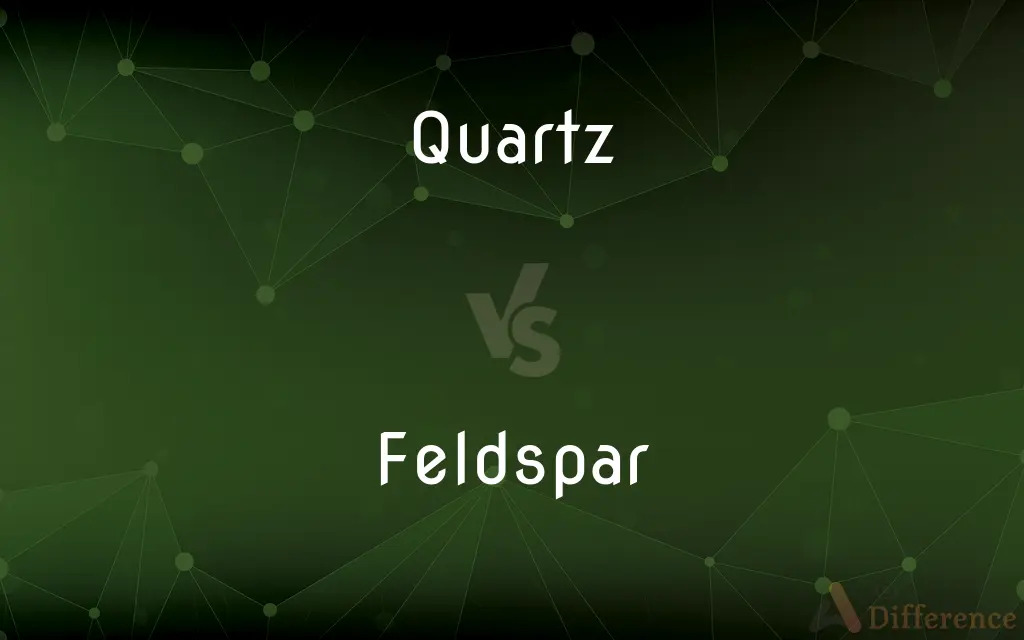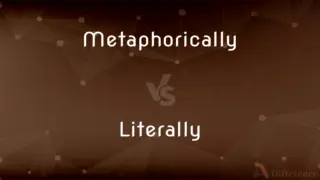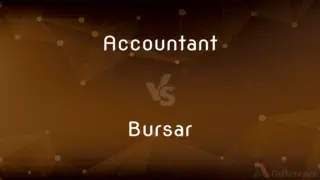Quartz vs. Feldspar — What's the Difference?
Edited by Tayyaba Rehman — By Fiza Rafique — Updated on March 21, 2024
Quartz is a hard, crystalline mineral composed of silica, widely known for its durability and use in jewelry, while feldspar, most abundant mineral in the Earth's crust, offers a variety of colors and is crucial in the manufacture of ceramics and glass.

Difference Between Quartz and Feldspar
Table of Contents
ADVERTISEMENT
Key Differences
Quartz, with its chemical formula of SiO2, is notable for its hardness and resistance to weathering, making it a common component of sand and an important industrial mineral. Feldspar, on the other hand, refers to a group of minerals containing potassium, sodium, calcium, or a combination of these elements, playing a key role in the formation of igneous, metamorphic, and sedimentary rocks.
The appearance of quartz can vary from colorless and transparent to colored varieties such as amethyst and citrine, which are prized in jewelry. Feldspar minerals, such as orthoclase and plagioclase, often show a range of colors from pink to light green, along with distinctive cleavage planes, making them easily recognizable to geologists.
Quartz is highly valued in the tech industry for its piezoelectric properties, which are used in electronic devices for frequency control and timing applications. Feldspar, due to its flux properties, is essential in the production of glass and ceramics, helping materials melt at lower temperatures and improving the strength and durability of the final product.
While quartz is chemically stable and does not easily alter to other minerals, feldspar is more susceptible to chemical weathering. This process can lead to the formation of clay minerals, contributing to soil fertility and influencing ecosystem dynamics.
In terms of economic importance, quartz is crucial not only for its use in jewelry but also in the production of glass, electronics, and as a filtration medium. Feldspar's economic significance lies in its widespread use in the ceramics and glass industries, as well as in paints, plastics, and rubber production.
ADVERTISEMENT
Comparison Chart
Composition
SiO2 (silicon dioxide)
Potassium, sodium, calcium aluminosilicates
Hardness
7 on Mohs scale
6-6.5 on Mohs scale
Industrial Uses
Electronics, glass, jewelry
Ceramics, glass, paints
Color Variations
Colorless, purple (amethyst), yellow (citrine), etc.
Pink, white, grey, green, etc.
Chemical Stability
High
Moderate (alters to clay minerals)
Compare with Definitions
Quartz
Resistant to weathering, contributing to its abundance in sand.
The beach's sand had a high quartz content, making it very durable.
Feldspar
Susceptible to chemical weathering, forming clay minerals.
The weathered feldspar contributed to the soil's fertility.
Quartz
Varieties include amethyst, citrine, and rose quartz.
The amethyst, a type of quartz, is valued for its vibrant purple color.
Feldspar
The most abundant group of minerals in the Earth's crust.
Granite is composed mostly of quartz and feldspar.
Quartz
A durable, crystalline mineral composed of silicon dioxide.
The quartz crystal sparkled under the sunlight.
Feldspar
Essential in the production of glass and ceramics.
Feldspar lowers the melting point in the glass-making process.
Quartz
Used in jewelry for its aesthetic appeal and durability.
Her necklace was adorned with a beautiful quartz pendant.
Feldspar
Exhibits a range of colors and distinctive cleavage.
The pink crystals in the rock were identified as feldspar.
Quartz
Integral to the tech industry for its piezoelectric properties.
Quartz oscillators are essential components in watches and smartphones.
Feldspar
Used in various industrial applications, including paints and plastics.
Feldspar is added to paints to improve durability.
Quartz
Quartz is a hard, crystalline mineral composed of silica (silicon dioxide). The atoms are linked in a continuous framework of SiO4 silicon-oxygen tetrahedra, with each oxygen being shared between two tetrahedra, giving an overall chemical formula of SiO2.
Feldspar
Feldspars are a group of rock-forming aluminium tectosilicate minerals, containing sodium, calcium, potassium or barium. The most common members of the feldspar group are the plagioclase (sodium-calcium) feldspars and the alkali (potassium-sodium) feldspars.
Quartz
A very hard mineral composed of silica, SiO2, found worldwide in many different types of rocks, including sandstone and granite. Varieties of quartz include agate, chalcedony, chert, flint, opal, and rock crystal.
Feldspar
Any of a group of abundant rock-forming minerals occurring in igneous, metamorphic, and sedimentary rocks, and consisting of silicates of aluminum with potassium, sodium, calcium, and, rarely barium. About 60 percent of the earth's outer crust is composed of feldspar.
Quartz
(mineral) The most abundant mineral on the earth's surface, of chemical composition silicon dioxide, SiO2. It occurs in a variety of forms, both crystalline and amorphous. Found in every environment.
Feldspar
(mineral) Any of a large group of rock-forming minerals that, together, make up about 60% of the earth's outer crust. The feldspars are all aluminum silicates of the alkali metals sodium, potassium, calcium and barium. Feldspars are the principal constituents of igneous and plutonic rocks.
Quartz
Crystal meth: methamphetamine hydrochloride.
Feldspar
A name given to a group of minerals, closely related in crystalline form, and all silicates of alumina with either potash, soda, lime, or, in one case, baryta. They occur in crystals and crystalline masses, vitreous in luster, and breaking rather easily in two directions at right angles to each other, or nearly so. The colors are usually white or nearly white, flesh-red, bluish, or greenish.
Quartz
A form of silica, or silicon dioxide (SiO2), occurring in hexagonal crystals, which are commonly colorless and transparent, but sometimes also yellow, brown, purple, green, and of other colors; also in cryptocrystalline massive forms varying in color and degree of transparency, being sometimes opaque.
Feldspar
Any of a group of hard crystalline minerals that consist of aluminum silicates of potassium or sodium or calcium or barium
Quartz
Colorless glass made of almost pure silica
Quartz
A hard glossy mineral consisting of silicon dioxide in crystal form; present in most rocks (especially sandstone and granite); yellow sand is quartz with iron oxide impurities
Common Curiosities
Why is quartz used in electronics?
Quartz possesses piezoelectric properties, making it valuable for precision devices like oscillators and timers in electronics.
How can you tell quartz and feldspar apart?
Quartz has no cleavage and is harder (7 on the Mohs scale), while feldspar has two or three directions of cleavage and is slightly softer (6-6.5 on the Mohs scale).
Can quartz and feldspar be found together?
Yes, they are both common constituents of igneous rocks such as granite.
Are there different types of feldspar?
Yes, the two main groups are potassium feldspars (orthoclase) and plagioclase feldspars, each with distinctive properties and uses.
Can feldspar be transparent like quartz?
Feldspar can be translucent to opaque; it is rarely as clear as quartz due to its structure and composition.
What distinguishes quartz from feldspar?
Quartz is a single mineral (silicon dioxide), known for its hardness and resistance to weathering, while feldspar refers to a group of minerals important in rock formation and industrial applications.
Why does feldspar weather to clay?
Feldspar weathers chemically in the presence of water and carbon dioxide, breaking down into clay minerals, which are more stable under surface conditions.
What are the piezoelectric properties of quartz?
Piezoelectricity refers to the ability of some materials to generate an electric charge in response to applied mechanical stress. Quartz is widely used for this property in electronic devices.
What makes feldspar important in ceramics production?
Feldspar acts as a flux in the ceramics industry, lowering the melting point of mixtures and improving the strength and durability of ceramics.
Is feldspar used in jewelry like quartz?
While some feldspar varieties, like moonstone and labradorite, are used in jewelry, quartz varieties are more commonly used due to their greater hardness and variety.
How does the color of quartz and feldspar differ?
Quartz can be clear or have colors ranging from purple to yellow, depending on impurities, while feldspar varies from pink to green, often with a milky or translucent appearance.
What role does quartz play in the sand formation?
Quartz's hardness and chemical stability make it a major component of sand, as it resists weathering and erosion.
Is quartz or feldspar more valuable?
The value depends on the specific use; quartz is highly valued in technology and jewelry, while feldspar is indispensable in ceramics and glass production.
What are the environmental impacts of mining quartz and feldspar?
Mining can lead to habitat destruction, water pollution, and dust generation, impacting local ecosystems and communities.
How does the use of quartz in glass making compare to feldspar?
Quartz is used for its silica content to form the glass, while feldspar acts as a flux to lower the melting temperature and improve the properties of glass.
Share Your Discovery

Previous Comparison
Metaphorically vs. Literally
Next Comparison
Accountant vs. BursarAuthor Spotlight
Written by
Fiza RafiqueFiza Rafique is a skilled content writer at AskDifference.com, where she meticulously refines and enhances written pieces. Drawing from her vast editorial expertise, Fiza ensures clarity, accuracy, and precision in every article. Passionate about language, she continually seeks to elevate the quality of content for readers worldwide.
Edited by
Tayyaba RehmanTayyaba Rehman is a distinguished writer, currently serving as a primary contributor to askdifference.com. As a researcher in semantics and etymology, Tayyaba's passion for the complexity of languages and their distinctions has found a perfect home on the platform. Tayyaba delves into the intricacies of language, distinguishing between commonly confused words and phrases, thereby providing clarity for readers worldwide.
















































